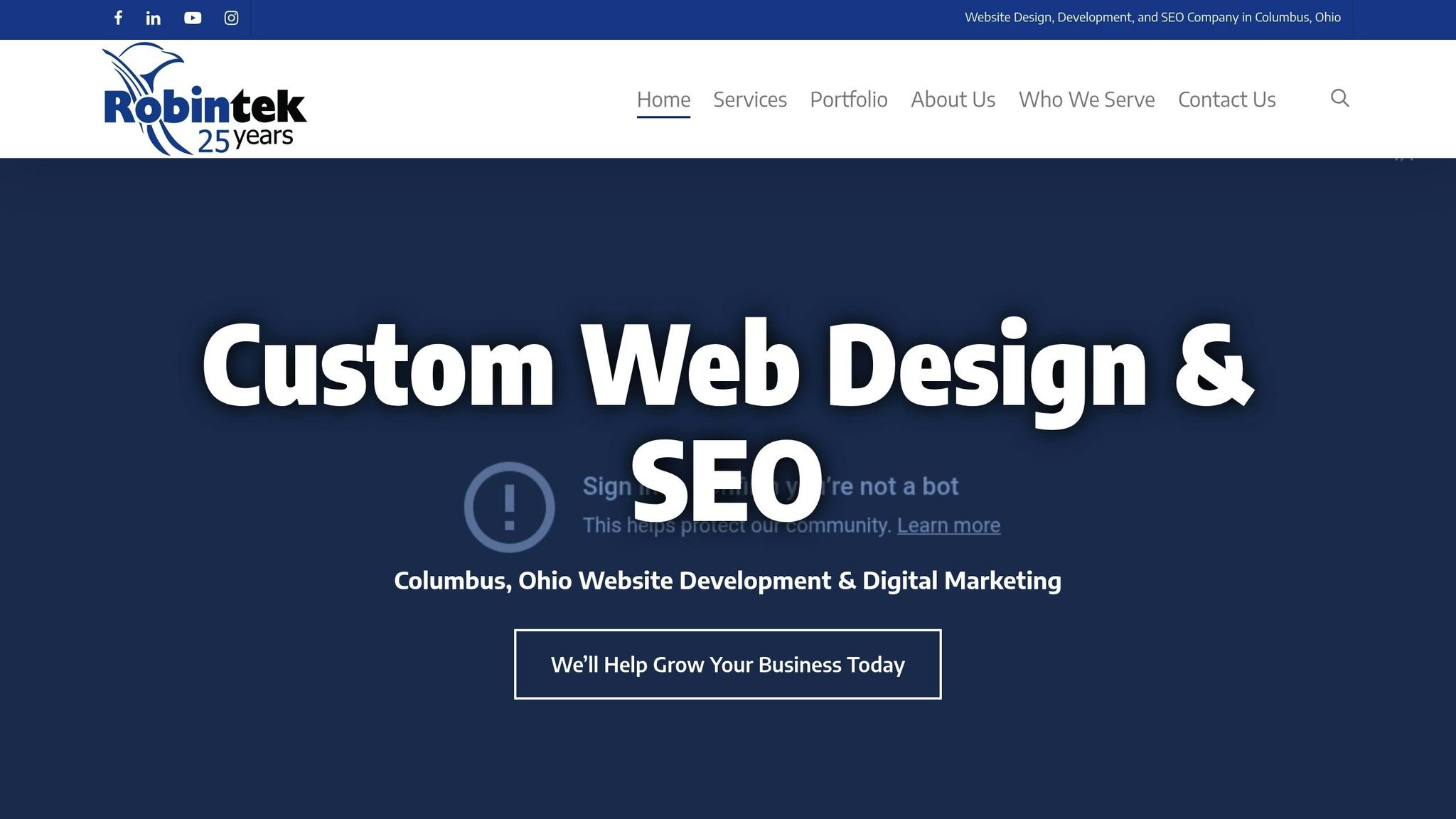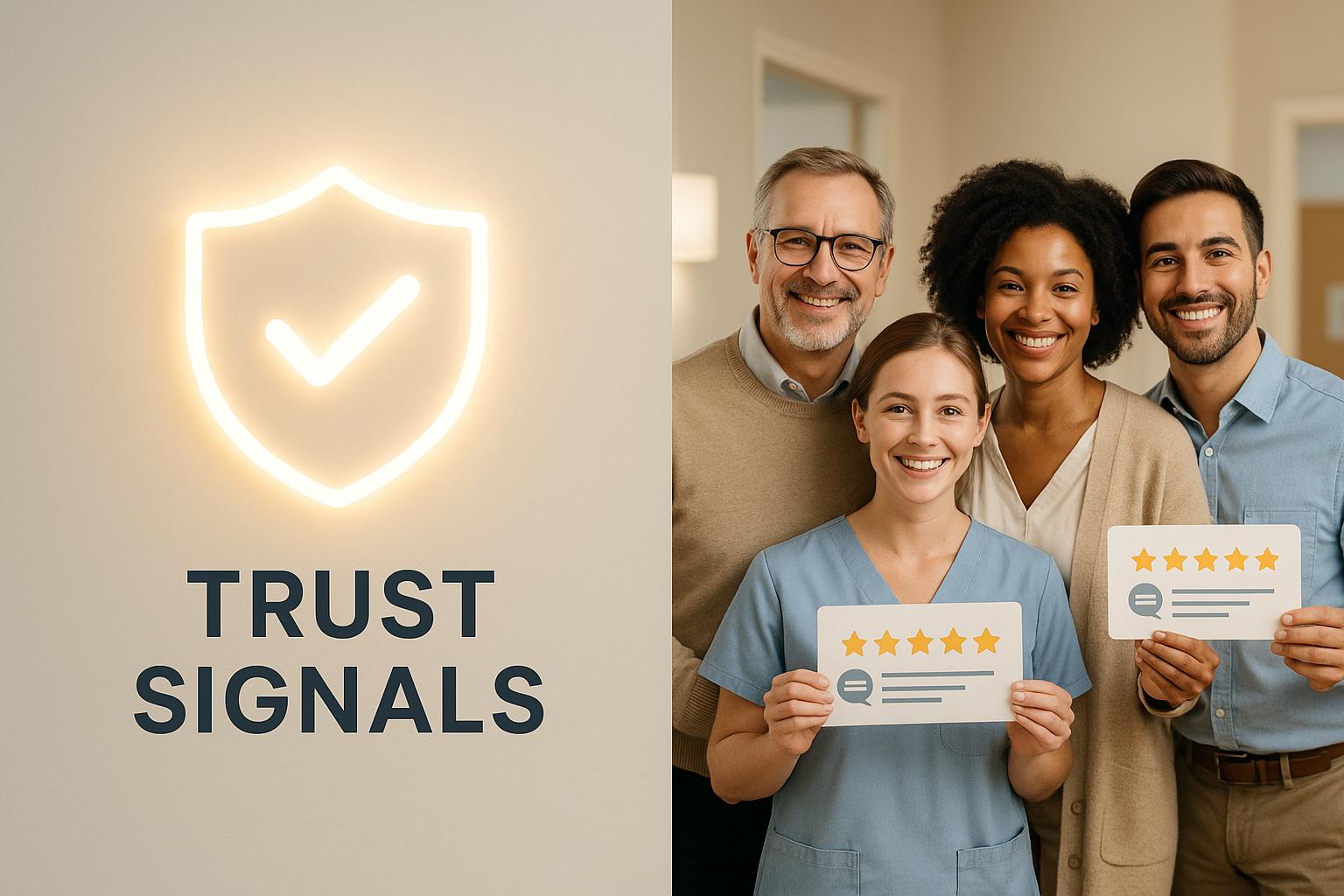When visitors land on your clinic’s website, they’re asking two key questions: “Can I trust this place?” and “Do others like me trust this place?” Trust signals and social proof answer these questions in different ways:
- Trust Signals: These are elements like certifications, security badges, and compliance logos that show your clinic is professional, safe, and legitimate. They appeal to logic and create an immediate sense of safety.
- Social Proof: This includes testimonials, reviews, and before-and-after photos that show others’ positive experiences. They appeal to emotions and build confidence.
Both are essential for converting visitors into patients. Trust signals work best during a visitor’s first interaction, while social proof is more effective later in the decision-making process. Together, they address concerns, build confidence, and increase conversions.
Here’s a quick comparison:
| Aspect | Trust Signals | Social Proof |
|---|---|---|
| Source of Credibility | Certifications, badges | Reviews, testimonials |
| Primary Purpose | Establish safety and legitimacy | Showcase satisfaction and results |
| Best Use | Homepages, forms | Service pages, testimonials |
Robintek Expert Video Series - Social Proof and Trust Signals

What Are Trust Signals?
Trust signals are the elements on your website that instantly convey your clinic's credibility, professionalism, and commitment to safety. Think of them as digital proof points that answer the question, "Can I trust this place with my health?" By addressing concerns upfront, trust signals help create a sense of security for potential patients.
In the aesthetic and wellness industry, trust signals are especially crucial. Patients aren't just buying a product - they're placing their physical well-being in your hands. They weigh factors like risk, comfort, expertise, and reputation before making a decision. This makes trust even more important when compared to other industries.
When someone visits your clinic's website, they form an opinion about your professionalism within the first five seconds. During this brief window, trust signals can ease doubts and reassure them about the safety of your services. Research shows that 75% of users judge a business's credibility based on its website design. For private healthcare providers, this judgment is even more critical because patients often trust national providers more readily. Trust signals help close this gap by offering immediate, tangible evidence of your clinic’s legitimacy. Below are some key types of trust signals that can make a difference for aesthetic practices.
Types of Trust Signals for Aesthetic Practices
Professional Certifications and Credentials
Displaying your board certifications, years of experience, and memberships in respected organizations like the American Society of Plastic Surgeons or the American Med Spa Association reinforces your expertise.
Security and Compliance Badges
Logos for HIPAA compliance, SSL certificates, and secure payment systems show that you prioritize protecting patient data and financial information.
Facility Accreditations and Safety Standards
Highlighting surgical facility accreditations, sterilization protocols, emergency procedures, and anesthesia practices demonstrates your commitment to patient safety - critical for procedures involving sedation or surgery.
Contact Information and Transparency
Providing easy-to-find phone numbers, physical addresses, and business hours builds trust through transparency. For example, one healthcare provider saw a nearly 50% jump in conversions after adding clear pricing and payment option details.
Visual Design Elements
Authentic, high-quality photos of your facility and staff help create a trustworthy first impression. Using calming colors like blue and green can also enhance feelings of trust and efficiency. Additionally, ensuring strong contrast between text and background improves readability, making your site accessible to all users.
How Trust Signals Build Credibility
When patients see clear trust signals, they feel reassured about your qualifications and professionalism. A well-organized website with visible credentials, safety standards, and facility images signals that you respect their concerns and are prepared to meet their needs.
Together, these elements create a polished online presence that makes your clinic feel approachable and dependable. For aesthetic practices offering premium services, trust signals are a cornerstone of effective marketing. Without them, even the most stunning before-and-after photos or glowing testimonials may not be enough to turn visitors into patients.
What Is Social Proof?
Social proof refers to the tendency of people to follow others' actions, especially when they're uncertain about a decision. It's the "if others are doing it, it must be good" mindset that shapes how we choose products, services, and experiences.
For clinics, showcasing real patient reviews, testimonials, photos, and case studies helps build trust by demonstrating successful outcomes.
This concept is especially impactful in the aesthetics and wellness industries, where decisions often involve considerable financial, emotional, and physical investment. Unlike buying a simple product, patients are putting their health, well-being, and appearance in your hands. Social proof bridges the gap between hesitation and confidence by offering peer validation and reassurance.
With the rise of online reviews, social media, and user-generated content, social proof has become even more influential. Patients now rely heavily on others' experiences when selecting healthcare providers, making it a crucial component of any clinic's marketing strategy.
Types of Social Proof for Clinics
Verified Patient Reviews and Ratings
Platforms like Google, Yelp, and healthcare-specific review sites allow patients to share detailed feedback about their experiences. These reviews provide prospective clients with insights into everything from consultations to recovery, helping them set realistic expectations.
Before-and-After Photo Galleries
Visual evidence of your clinic's work offers prospective patients a clear picture of what they might achieve. These galleries highlight your expertise and help potential clients imagine their own transformations. In aesthetics, where results are highly visual, this type of proof is particularly persuasive.
Video Testimonials
Video testimonials bring an emotional and authentic touch that written reviews often lack. Seeing and hearing real patients share their positive experiences fosters a stronger sense of trust and connection.
Detailed Case Studies
Case studies that detail a patient's journey - from initial consultation to final results - offer in-depth insights into how your clinic addresses specific concerns. These stories resonate with prospective patients who face similar challenges.
User-Generated Content (UGC)
Photos, stories, and posts shared by patients on social media provide a genuine glimpse into their experiences. Because this content comes directly from patients, it often feels more relatable and trustworthy, creating a sense of community among potential clients.
Industry Expert Endorsements
Endorsements from respected professionals like dermatologists, plastic surgeons, or wellness influencers add credibility. These recommendations signal expertise and can reassure hesitant patients.
How Social Proof Influences Decisions
Social proof taps into fundamental psychological principles. When faced with unfamiliar situations, people naturally look to others for guidance - especially when the stakes are high. In aesthetics and wellness, where patients often feel vulnerable about their appearance or health, knowing others have had positive experiences provides vital reassurance.
Consider these numbers: 91% of consumers check at least one review before making a purchase, and 71% are influenced by social media recommendations. In the U.S., 80% of consumers seek recommendations before buying anything. These statistics highlight how deeply social proof shapes decision-making today.
Clinics that actively incorporate social proof into their strategies see measurable benefits. For instance, businesses leveraging these techniques generate 51% more leads than those that don't. This demonstrates that social proof not only builds confidence but also directly impacts revenue.
The effectiveness of social proof lies in several psychological triggers. People trust feedback from others who share similar concerns, value expert opinions, and are swayed by the sheer volume of positive experiences. For example, seeing dozens of five-star reviews from patients with similar needs creates a "bandwagon effect" that motivates action.
In the aesthetics and wellness space, where treatments are personal and often involve visible changes, social proof is particularly compelling. Patients want to feel assured that others have not only undergone the process but are thrilled with the results.
The key is to ensure your social proof feels genuine and relatable. U.S. consumers increasingly value transparency and authenticity in reviews and testimonials. Verified patient feedback and real case studies carry far more weight than generic claims or stock images. By focusing on authentic stories, clinics can build trust and connect with prospective patients on a deeper level.
sbb-itb-02f5876
Main Differences Between Trust Signals and Social Proof
Trust signals and social proof both play a role in building credibility, but they serve different purposes and operate in distinct ways. The key difference lies in where their credibility stems from: trust signals rely on third-party validation - such as certifications, regulatory bodies, or professional associations - while social proof draws strength from peer experiences and community feedback.
Trust signals are most effective during a prospect's first interaction with a brand. They address key concerns about professionalism, compliance, and safety. On the other hand, social proof becomes more influential later, during the decision-making phase, when potential clients are evaluating what their personal experience might be like.
The psychological triggers they activate also differ. Trust signals appeal to our need for authority and security, reassuring us that a business is legitimate and safe. Social proof, however, taps into peer validation, boosting confidence by showing that others have had positive outcomes. This difference naturally influences how and where these elements are best used.
For example, 83% of consumers cite trust as a key factor in their buying decisions, and brands that effectively incorporate trust elements see conversion rate increases of 15% to 40%. Meanwhile, 92% of people hesitate to make a purchase if no customer reviews are available. These statistics highlight the complementary roles of trust signals and social proof in guiding consumer behavior.
In terms of format, trust signals are generally static - think badges, certifications, or security seals - designed to provide a consistent and professional appearance. Social proof, by contrast, is dynamic and personal, often taking the form of reviews, testimonials, before-and-after photos, or case studies. While trust signals reduce anxiety about safety and legitimacy, social proof creates an emotional connection, showcasing real-world results and fostering aspiration.
Another distinction lies in their adaptability. Trust signals are harder to A/B test because they build credibility over time, whereas social proof can be tested more directly by experimenting with different testimonials, review formats, or case study layouts. These differences in source, timing, and format are summarized below:
Comparison Table: Trust Signals vs. Social Proof
| Aspect | Trust Signals | Social Proof |
|---|---|---|
| Credibility Source | Third-party authorities, certifications | Peer experiences, customer feedback |
| Primary Function | Establish legitimacy and safety | Showcase satisfaction and results |
| Best Placement | Homepages, forms, checkout areas | Service pages, testimonials sections |
| Buyer's Journey Stage | Awareness and early consideration | Consideration and decision phases |
| Content Type | Static badges, certifications, security seals | Dynamic reviews, case studies, photos |
| Psychological Trigger | Authority and safety | Social validation and peer influence |
| Update Frequency | Rarely changes | Regularly updated with fresh content |
| Emotional Impact | Reassures and reduces anxiety | Builds aspiration and emotional connection |
| Measurement Focus | Overall conversion rates | Engagement metrics and specific actions |
Integrating these elements effectively requires careful timing. Trust signals answer the question, "Can I trust this clinic?" while social proof addresses, "Will I be happy with my results?" Together, they create a well-rounded framework that builds confidence at every stage of the customer journey.
"The paradox of trust is that the harder you visibly try to establish it, the more suspicious consumers become of your motives." - Mark Ritson, Digital Marketing Expert
This quote serves as a reminder that balance is key. Overloading on trust signals or social proof can backfire, making prospects skeptical. Instead, these elements should be placed thoughtfully and naturally, addressing genuine concerns at the right moments in the decision-making process.
Using Trust Signals and Social Proof Together for Better Lead Conversion
Combining trust signals with social proof is a game-changer for boosting lead conversion. The most successful aesthetic and wellness practices don’t treat these elements as separate strategies. Instead, they blend them to create a credibility framework that works across the entire customer journey. This layered approach helps address customer concerns at every stage, increasing the chances of turning casual browsers into confirmed appointments.
While trust signals build immediate legitimacy, social proof adds an emotional layer of validation as potential clients explore further. By placing trust signals at initial touchpoints and reserving social proof for later stages, practices can guide visitors seamlessly from curiosity to commitment.
Best Practices for Placement
- Homepage: Highlight trust signals such as certifications, board memberships, or security badges prominently. Pair these with a brief testimonial or a compelling patient satisfaction stat to hint at the positive experiences awaiting visitors.
- Service Pages: Use a mix of trust signals and social proof. For example, certifications can highlight expertise, while before-and-after galleries or testimonials showcase real-world results. This combination builds confidence in both the quality of care and expected outcomes.
- Contact and Booking Areas: Position trust signals like security badges or HIPAA compliance notes near forms to reduce drop-offs. A glowing review or testimonial nearby can provide the final nudge for hesitant visitors.
- Mobile Devices: Prioritize key trust signals and social proof elements in a user-friendly way. Expandable sections or carousels can display multiple testimonials without cluttering the screen.
- Footer: This is the perfect spot for comprehensive trust signals, such as professional associations, awards, or years of practice. These elements reassure visitors without competing for attention on the main page.
To execute these strategies effectively, many clinics rely on advanced tools for seamless integration.
Using Prospyr for Credibility Management

Platforms like Prospyr make it easier to manage and display trust signals and social proof across all patient touchpoints. With its HIPAA-compliant infrastructure, Prospyr immediately addresses patient concerns about data security and regulatory compliance - key trust signals for any practice.
Prospyr also simplifies the process of gathering and showcasing social proof. Its review management system automates follow-up communications with satisfied patients, ensuring a steady stream of fresh testimonials and online reviews. This not only enhances credibility but also strengthens the practice’s reputation across multiple platforms.
Additionally, Prospyr’s digital intake forms keep trust signals consistent throughout the patient experience. Leads captured from websites and social media flow directly into the platform’s CRM, ensuring cohesive messaging across all channels.
The platform’s analytics capabilities allow practices to track which combinations of trust signals and social proof are most effective at driving conversions. This data-driven approach enables practices to refine their strategies based on real patient behavior.
The results speak for themselves. Dr. Daniel Lee, Founder of New Life Cosmetic Surgery, reported a 50% increase in revenue and a 40% boost in booked appointments after implementing Prospyr. SOM Aesthetics achieved even faster success, hitting launch sales targets 21 times faster than expected and generating $40,000 in revenue within just two days. Dr. Saami Khalifian, Founder and CEO of SOM Aesthetics, shared:
"Prospyr has helped us launch SOM Aesthetics like a rocketship. Their powerful platform and helpful support have enabled us to exceed our financial targets while delivering an unmatched experience for our patients." – Dr. Saami Khalifian, Founder and CEO, SOM Aesthetics
Conclusion: Balancing Trust Signals and Social Proof
Turning visitors into leads requires a thoughtful mix of trust signals and social proof to craft a strong credibility framework. Trust signals lay the groundwork by addressing the question, "Can I trust this clinic?" Social proof then reinforces that trust by showing, "Do others benefit from their services?" Together, these elements ease safety concerns and appeal to emotional motivators.
This layered strategy is key to generating leads effectively. It’s why the most successful aesthetic and wellness practices don’t rely on a single approach. Instead, they combine these elements to guide potential patients from initial doubts to confident decisions.
The right balance depends on the size and specialty of the practice. Smaller or newer clinics should focus on social proof, such as patient testimonials and before-and-after photos, to quickly build trust while working on formal credentials. On the other hand, established clinics can lean on their trust signals - like board certifications, years of experience, and professional accolades - while using social proof to highlight ongoing patient satisfaction.
Tailoring this balance to your audience is crucial. For example, aesthetic clinics targeting younger patients might emphasize Instagram-style social proof and user-generated content. Meanwhile, wellness practices catering to older demographics may find formal medical certifications and HIPAA compliance badges more effective in building trust.
In the U.S., regulatory and cultural factors add complexity. With 91% of American shoppers checking reviews before making a decision, social proof is a must. At the same time, healthcare consumers expect visible compliance with regulations like HIPAA, making privacy and security certifications equally vital.
Real-world examples illustrate how this strategy works. A mid-sized aesthetics clinic in California implemented a mix of trust signals and social proof, resulting in a 35% increase in online lead conversions and a 20% drop in appointment no-shows within six months.
To succeed, avoid overloading your website with too many trust badges or outdated testimonials. Focus on quality, keep your content fresh, and regularly audit your site. The goal is to create a genuine, trustworthy experience that aligns with your patients' concerns and expectations.
When done right, this balanced approach transforms your website from a basic information hub into a powerful tool that builds confidence and drives conversions at every step.
FAQs
What’s the best way to use trust signals and social proof on my clinic’s website to boost patient conversions?
To increase patient conversions, it’s crucial to use trust signals and social proof effectively on your website. Highlight patient reviews, testimonials, and before-and-after success stories - these relatable examples help reassure potential patients and make your services more persuasive. Adding certifications, professional affiliations, and a HIPAA compliance badge further reinforces your clinic’s credibility and professionalism.
You can also incorporate real-time features like appointment availability or display the number of satisfied patients to create a sense of urgency and showcase your clinic’s popularity. Strategically place these elements on high-impact areas like landing pages, service descriptions, or booking sections. Tools like Prospyr can simplify this process by automating tasks such as review management and patient communication, making it easier to build trust while improving the overall patient experience.
What’s the difference between trust signals and social proof, and how do they impact patient decisions?
Trust signals and social proof play distinct but complementary roles in building confidence and guiding decisions.
Trust signals emphasize authority, expertise, and dependability. Think of things like professional certifications, secure payment icons, or adherence to regulations such as HIPAA. These elements project credibility and professionalism, ensuring patients feel safe and confident in their choice.
Social proof, meanwhile, taps into the influence of shared experiences and peer validation. Patient testimonials, online reviews, or even showcasing the number of satisfied clients all serve to reassure potential patients. Seeing others achieve positive results helps reduce doubts and motivates action.
By addressing both the logical and emotional sides of decision-making, these tools work together to foster trust and encourage engagement.
What’s the difference between trust signals and social proof, and why is it important to balance them?
Trust signals and social proof are both key to building credibility and turning website visitors into leads, but they serve distinct roles. Trust signals include elements like security badges, certifications, or privacy assurances that convey reliability and a professional image. Meanwhile, social proof - such as reviews, testimonials, or user-generated content - shows that others have had positive experiences with your product or service.
Striking the right balance between the two is essential. Leaning too much on trust signals without incorporating social proof might make your business feel distant or unproven. On the flip side, relying solely on social proof without solid trust indicators could leave potential customers questioning your professionalism or security. Combining both effectively creates a stronger, more balanced foundation of trust and confidence for your audience.



